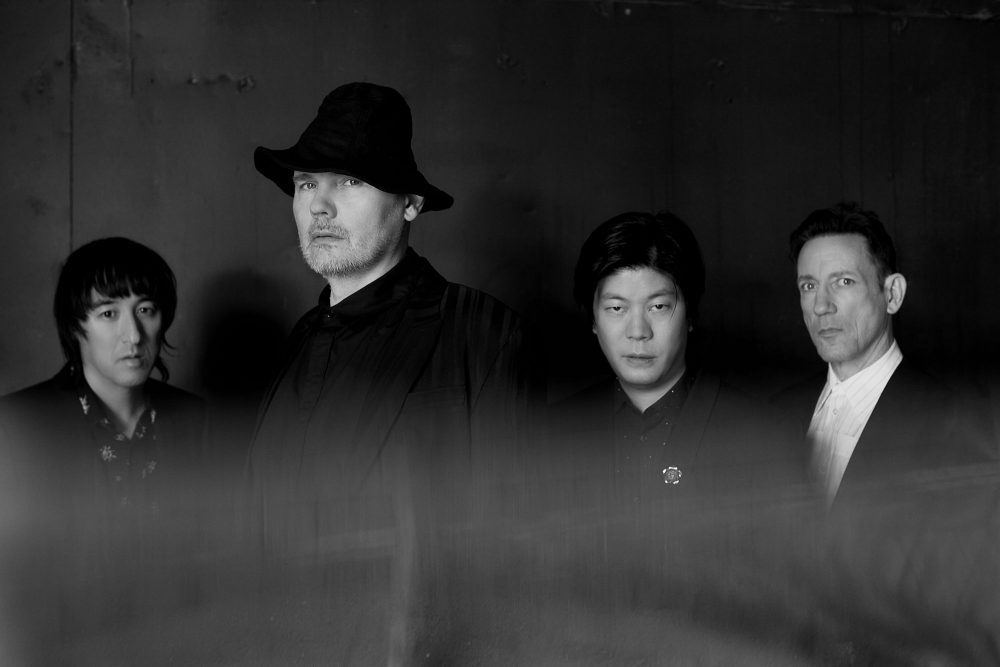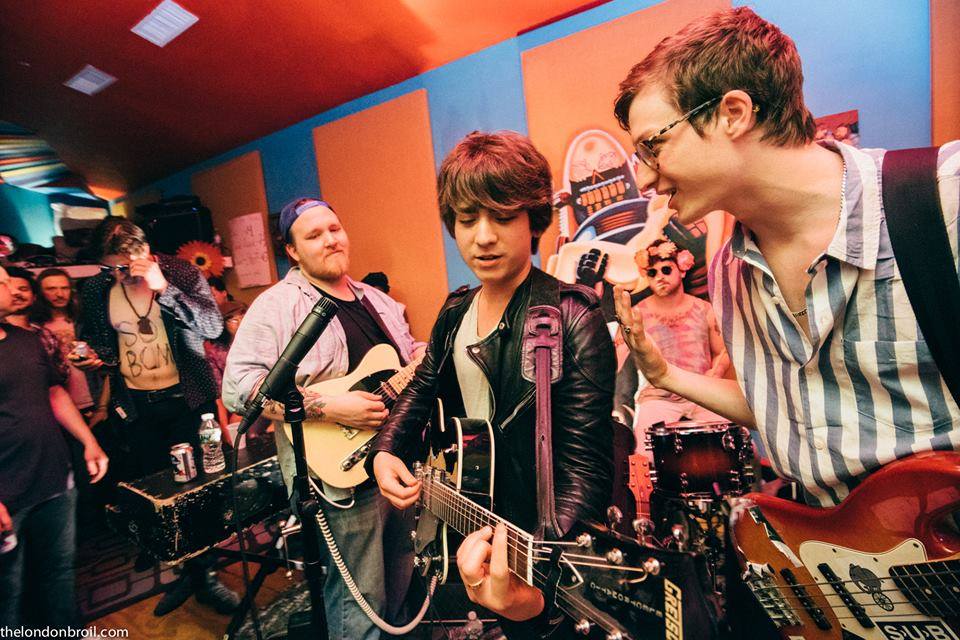

Twenty-five years ago, the Smashing Pumpkins released Mellon Collie and The Infinite Sadness, an epic double album packed with ferocious industrial-style rock like “Zero” and “Bullet With Butterfly Wings” but also with nostalgic, sentimental tracks, fuzzy with youthful romance, like “1979” and “Tonight, Tonight.” It entranced a generation of teenagers seeking escape from the daily ordinariness of their lives.
Mellon Collie, released in October 1995 – the third album for the foursome, following 1991 debut Gish and 1993 breakout Siamese Dream – debuted at number one on the US Billboard charts, still the only Pumpkins album to do so. It would go on to be certified Diamond by the RIAA, meaning it has sold more than 10 million copies. Produced by Flood and Alan Moulder, the sound was – as Flood is known for – anthemic, authentic and huge.
“We were just so focused on being successful on our own terms…we weren’t seeing much past 1995, honestly,” recalls Corgan, 53. “The label had pushed other people, more ‘successful’ rock producers, and I turned them all down. Flood was my personal choice. His work with Depeche Mode, U2, Nitzer Ebb, PJ Harvey – he’s a great human being and a great producer. He’d suggested Alan Moulder, since they were very close friends, so that’s how we ended up with the triumvirate of me, Flood and Alan.”
Corgan had announced to the label, Virgin Records, that he intended on recording a double album; they immediately tried to talk him out of it. Unsuccessfully, obviously. The fame that followed the success of Mellon Collie was a surprise to the band, which then consisted of Corgan, guitarist James Iha, drummer Jimmy Chamberlin and bassist D’arcy Wretzky.
“I don’t think we were really prepared for that level of attention,” says Corgan. “We’d come from the indie world. To be famous in the indie world, you’d play to a thousand people and your friends knew who you were. Suddenly, you’re on the cover of the most mainstream magazines and they’re asking you the dumbest fucking questions. Anyone who’s wise goes along with it because they want to get more famous, but we, of course, thought it was all kinda stupid, so we resisted it and probably made it more complicated for ourselves.”
Touring behind Mellon Collie created strain for the band; Chamberlin was fired after suffering a heroin overdose in New York City with the band’s touring keyboardist, Jonathan Melvoin, who died. Though Chamberlin returned to the band in 1999, Wretzky was replaced by Hole bassist Melissa Auf der Maur that same year, before the Pumpkins broke up “for good” in 2000. Various reunions and side projects in the years since have reconfigured the lineup with some original members, though Corgan has been the group’s only constant.
While Wretzky has rejected offers to reunite with the band, Corgan and Iha have remained especially close. “We were friends early on and connected very deeply on music,” Corgan explains. “As we’ve grown into very different types of people, it’s more like brothers. You don’t totally understand your brother, and I don’t think he totally understands me, but the thing we really connect on – the music – is the thing that’s always brought us back to the table.” Rather than the excesses of rock stardom, conversations are tame these days. “We mostly talk about family,” says Corgan. “He has two children, I have two, and Jimmy Chamberlin has two. It’s mostly like ‘elder dad talk’, or something.”
I saw Mellon Collie performed live in Melbourne in the late 1990s, where the album songs translated effortlessly to the live environment, I tell Corgan.
“It was actually Flood who insisted that the band who made Mellon Collie was more like the live band than the studio band,” Corgan says. “He wanted the live ferocity on record. He insisted that we try to capture that and we went out of our way to try to do that. Performances of the Mellon Collie album were an extension of that philosophy, which was: the darker and heavier we were, the better.”
The cost of the darkness and heaviness was a burden though, which Corgan can reflect on in the clarity of time.
“I think if you go out in front of ten thousand people and you create chaos, just because you stop playing the concert, it doesn’t mean the chaos in your head ends,” he says. “I do think it opens the door to a lot of bad behavior. You end up self-medicating to try to control something that really can’t be controlled. To go into that kind of energetic chaos on a routine basis makes for good art, but it’s definitely not healthy.”
Corgan admits he was in therapy for years, took “many spiritual journeys,” and yet maintains that there’s no way to truly understand what that kind of fame does to you until you’ve been through it.
“Human beings, at least in the 20th and 21st centuries, have come to worship fame as the ultimate currency,” says Corgan. “There’s no psychological manual for that, so only God can translate that, in my experience, into something more powerful and potent and less dependent on whether or not you’re being approved of or loved.”
To that end, the newest Smashing Pumpkins release, Cyr, has received mixed critical responses.
Corgan’s intention for Cyr was to invite listeners further into his imagination – beyond purely music-enabled communion – via a visual and animated dimension to the album. The album’s 20 tracks were released in increments over three months.
Notably, Cyr is the first Smashing Pumpkins album since Mellon Collie that unites the trio of Chamberlin, Iha and Corgan. Far from the angst-fueled, exploding hormones and extraordinary dream-like world of Mellon Collie, Cyr is almost a throwback to ’80s synth-glam pop. It’s not quite the darkness and romance of Depeche Mode, nor does it recall the gothic influences Corgan loved as a teen. What it’s not matters, because it seems to have cut off the limbs of a body of music that Corgan and Iha grew up obsessed with: Bauhaus, Joy Division, The Cure. Cyr is sugar-coated in digital wizardry: The synth samples, the handclaps, the perfectly aligned tempo, melody, and harmony that is made easy when watching a timeline on a computer. It is the sound of Corgan discovering and delighting in technology, so that some of the tracks sound like old Apogee games.
In comparison to the vulnerability, the clashing and contrasting beauty and rage of Mellon Collie, Cyr is glossy, glitchy surfaces that, while catchy, fall a bit short of the brain-tingling, synapse-exploding miniature universes that Mellon Collie surprised us with 25 years ago.
But fear not. Corgan and the two remaining members of the Smashing Pumpkins are currently in the process of recording a double-album sequel to Mellon Collie, that, like the original, offers 33 songs. Iha is recording his parts in Los Angeles, while Corgan and Chamberlain are recording theirs in a studio near Corgan’s home just outside Chicago.
What will the double album sequel to Mellon Collie reveal? Does Cyr give an indication that the next iteration will be digital, algorithm-driven and animated? Or is Cyr a red herring, designed to lull listeners into a safe place before Mellon Collie 2.0 smashes all our assumptions and predictions? We won’t know until it arrives, likely some time in 2021. But Corgan is at peace with how fans respond to his work, past, present, or future.
“If I create something that you love, and the next person hates, it’s kind of the same thing to me,” he says. “The human mind always wants approval, but I don’t operate on those precepts. Of course, I’d prefer you to like the record and what I’m doing, but it doesn’t have anything to do with why I do it.”
That’s between Corgan, his guitar and his God.
Follow The Smashing Pumpkins on Facebook for ongoing updates.




